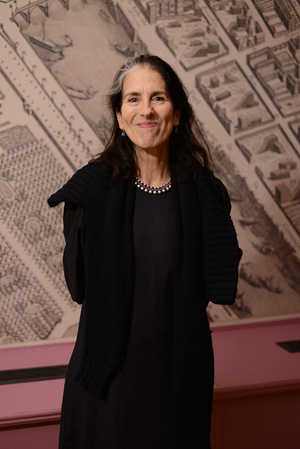From the Exhibition:
Thomas Hope: Regency Designer, A Curatorial Interpretation of the Egyptian Room at Duchess StreetDesigner, patron, collector, and author Thomas Hope (1769–1831) is one of the major figures in the history of British design and helped shape and define what became known as “Regency Style,” a mode of design and decoration that continues to be influential. In this first in a series of articles inaugurating the “Object of the Month” web column, Nina Stritzler-Levine, chief curator and executive editor of Gallery publications at the BGC, writes about the curatorial concepts that shaped the installation of Hope’s work at the Bard Graduate Center Gallery.
The exhibition Thomas Hope: Regency Designer at the Bard Graduate Center focuses on an aspect of curatorial inquiry that is concerned with how works of art are interpreted and displayed. Whether it is a museum, gallery or even a home, display spaces construct and constitute meaning. In the case of the curatorial interpretation of Thomas Hope, where and why works of art were shown together has a particular historical relevance because many of the objects in the exhibition were collected or designed by Hope and first shown at his townhouse on Duchess Street in London after 1802. Hope envisioned his townhouse as both a private domain and public space for visitors to see his collection. The rooms on the first floor were conceived as a unified ensemble. Furnishings and works of art were arranged thematically and to signify quality in design and interior decoration. Thus the interior plan of Duchess Street identifies interiors by place names such as Egypt and India or refers to a specific work of art that was the centerpiece of an ensemble.
Thomas Hope: Regency Designer is the perfect exhibition with which to begin our on-line “Object of the Month” discussion because of the relationship it suggests between past and present, object and interpretation. For the BGC gallery, a succession of intimate spaces, is typologically related to Duchess Street although on a smaller scale. A renovated Beaux Arts townhouse that evokes an atmosphere more reminiscent of a domestic setting than a conventional museum or art gallery it is therefore uniquely suited for the display of this exhibition. While the pedestals and platforms that support many of the objects on view delineate an exhibition display, the installation design is nevertheless “Duchess Street-like.” Questions about how display affects interpretation, and how present approaches can grasp the past more or less completely, and in what dimension—these questions are obvious here, though in fact are central to all our exhibitions.
The connection is vividly apparent on the second floor of the gallery that features the pair of armchairs shown here that were originally on display in the Egyptian Room at the Duchess Street townhouse among Hope’s collection of Egyptian antiquities. The pair of chairs exemplifies the highly idiosyncratic juxtaposition of sources and details that characterize Hope’s contribution to Regency furniture design. Painted black with gilt bronze mounts the actual vocabulary of ornament derives from Egyptian, Greek and Roman art. These chairs also reveal the peculiarities of display and collecting and authenticity and invention associated with Duchess Street.
Hope’s identity as a collector is both a personal history and a broader narrative about the material world at the beginning of the nineteenth century. Following the French Revolution in 1789 the collecting and exhibiting of works of art that had been largely restricted to monarchs and the aristocracy became a more widespread form of professional practice and a public phenomenon with strong nationalistic associations. Hope’s home was one of the first display spaces intended for public consumption and edification. In 1804 he invited members of the Royal Academy to Duchess Street and other visitors followed with Hope actually selling admission tickets. The basis for his collection was the grand tour he took to the Continent and the Ottoman Empire over a period of twelve years from 1787 to 1798. He traveled to locations that lured visitors from the West for their culture and exoticism. Constantinople, Ephesus, the Aegean islands, mainland Greece and Egypt were among his destinations. Hope also commissioned contemporary artists and craftsmen to create works that in various ways emulated the cultural and aesthetic ideals he greatly admired in the art and artifacts of antiquity.

